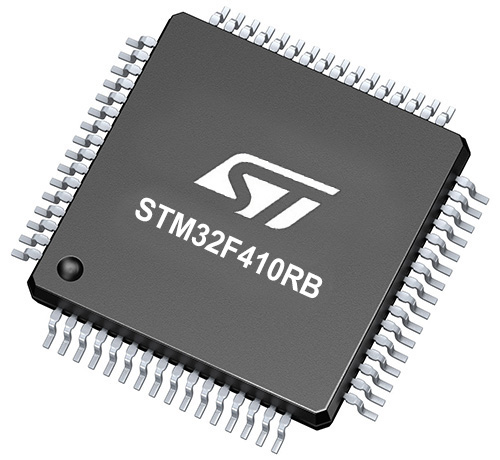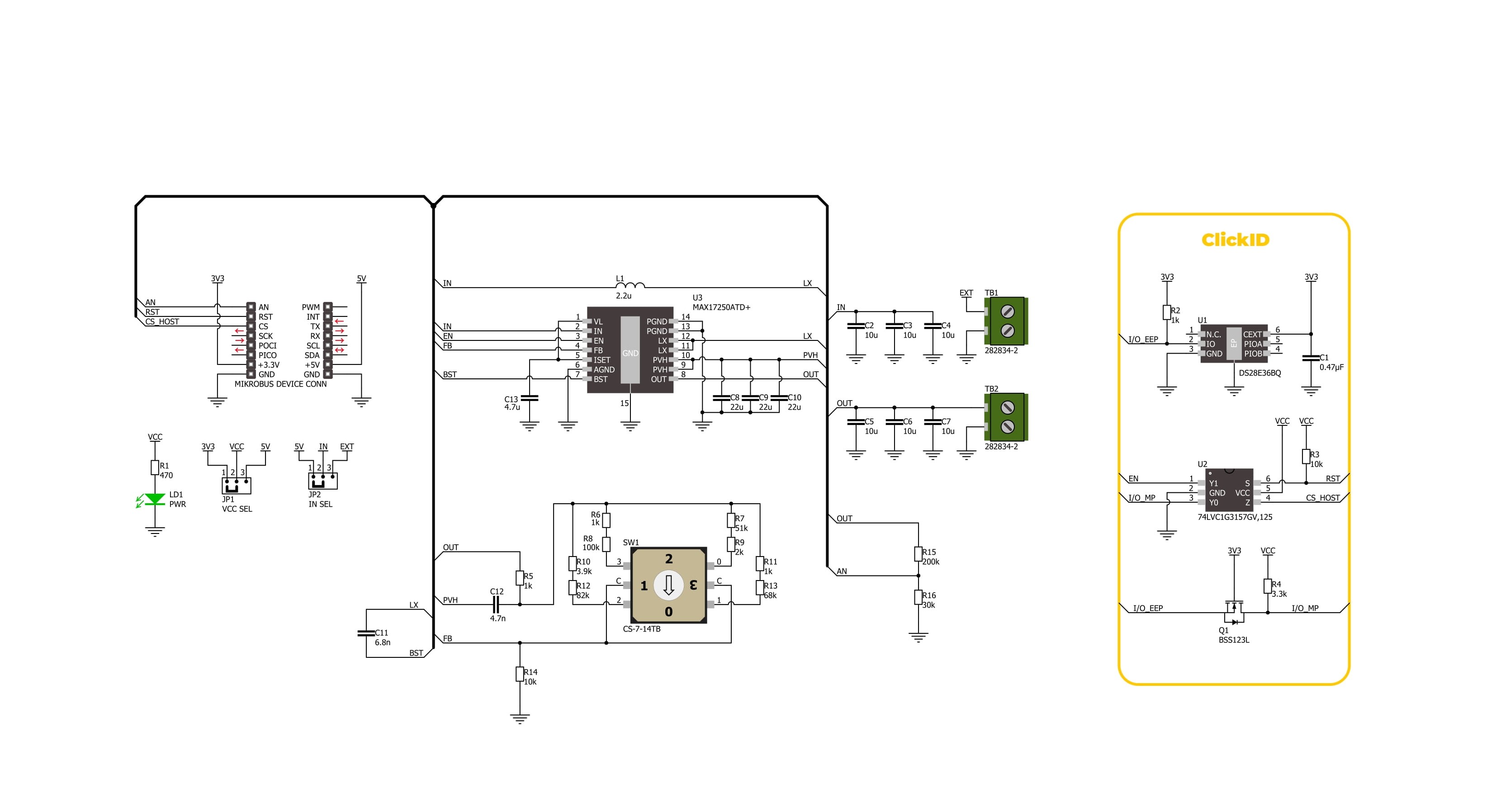Boost voltage with ultra-low power consumption and True Shutdown™ perfect for battery-powered IoT devices, display power, and alarm drivers
A
A
Hardware Overview
How does it work?
Boost 5 Click is based on the MAX17250, a DC-DC synchronous step-up converter from Analog Devices. Designed to deliver exceptional power efficiency with minimal energy consumption, this Click board™ is ideal for battery-powered applications requiring a stable and reliable voltage boost. With its wide input voltage range, the MAX17250 steps up the voltage to as high as 14V (with peak current limit of 3.5A) while maintaining a low quiescent current operation. One of its standout features is True Shutdown™. This unique capability ensures complete disconnection of the output from the input, reducing battery drain to a mere 0.1µA in shutdown mode, significantly extending battery life in portable and low-power applications, including battery-powered IoT devices, single or dual-cell Li-Ion battery-powered systems, buzzer/alarm drivers, as well as display power supplies. The MAX17250 operates in three operational modes to optimize performance based on the system’s requirements. At startup, the soft-start mode ensures a smooth
power-up sequence, preventing inrush currents that could destabilize the system. Once operational, the converter functions using a fixed on-time and minimum off-time Pulse Frequency Modulation (PFM) architecture, which only activates the switching regulator when necessary, achieving an ultra-low typical quiescent current of just 60µA. Additionally, its integrated short-circuit protection further enhance reliability and safe operation under varying load conditions. This Click board™ features a four-position switch that allows users to select the desired regulated output voltage at the VOUT terminal, providing flexibility for different application needs. The switch positions correspond to four preset voltage levels: 8V at position 0, 10V at position 1, 12V at position 2, and 14V at position 3. Additionally, the board includes two pins for enhanced operation and monitoring. The EN pin serves as a device-enable control, allowing the user to activate or deactivate the boost converter as needed, while the AN pin functions as a digital
output, providing real-time feedback on the board’s output voltage at the VOUT terminal. Boost 5 Click also offers versatile power sourcing options, allowing users to choose between internal and external supplies to best suit their application needs. This flexibility is achieved through the VIN SEL jumper, which enables users to select the 5V position for sourcing power internally via the 5V mikroBUS™ power rail or the EXT position to connect an external power supply (supplied via the VEXT terminal). The external power supply can range from 2.7V to 18V, providing a wide voltage range for various project requirements. This Click board™ can operate with either 3.3V or 5V logic voltage levels selected via the VCC SEL jumper. This way, both 3.3V and 5V capable MCUs can use the communication lines properly. Also, this Click board™ comes equipped with a library containing easy-to-use functions and an example code that can be used as a reference for further development.
Features overview
Development board
Nucleo-64 with STM32F410RB MCU offers a cost-effective and adaptable platform for developers to explore new ideas and prototype their designs. This board harnesses the versatility of the STM32 microcontroller, enabling users to select the optimal balance of performance and power consumption for their projects. It accommodates the STM32 microcontroller in the LQFP64 package and includes essential components such as a user LED, which doubles as an ARDUINO® signal, alongside user and reset push-buttons, and a 32.768kHz crystal oscillator for precise timing operations. Designed with expansion and flexibility in mind, the Nucleo-64 board features an ARDUINO® Uno V3 expansion connector and ST morpho extension pin
headers, granting complete access to the STM32's I/Os for comprehensive project integration. Power supply options are adaptable, supporting ST-LINK USB VBUS or external power sources, ensuring adaptability in various development environments. The board also has an on-board ST-LINK debugger/programmer with USB re-enumeration capability, simplifying the programming and debugging process. Moreover, the board is designed to simplify advanced development with its external SMPS for efficient Vcore logic supply, support for USB Device full speed or USB SNK/UFP full speed, and built-in cryptographic features, enhancing both the power efficiency and security of projects. Additional connectivity is
provided through dedicated connectors for external SMPS experimentation, a USB connector for the ST-LINK, and a MIPI® debug connector, expanding the possibilities for hardware interfacing and experimentation. Developers will find extensive support through comprehensive free software libraries and examples, courtesy of the STM32Cube MCU Package. This, combined with compatibility with a wide array of Integrated Development Environments (IDEs), including IAR Embedded Workbench®, MDK-ARM, and STM32CubeIDE, ensures a smooth and efficient development experience, allowing users to fully leverage the capabilities of the Nucleo-64 board in their projects.
Microcontroller Overview
MCU Card / MCU

Architecture
ARM Cortex-M4
MCU Memory (KB)
128
Silicon Vendor
STMicroelectronics
Pin count
64
RAM (Bytes)
32768
You complete me!
Accessories
Click Shield for Nucleo-64 comes equipped with two proprietary mikroBUS™ sockets, allowing all the Click board™ devices to be interfaced with the STM32 Nucleo-64 board with no effort. This way, Mikroe allows its users to add any functionality from our ever-growing range of Click boards™, such as WiFi, GSM, GPS, Bluetooth, ZigBee, environmental sensors, LEDs, speech recognition, motor control, movement sensors, and many more. More than 1537 Click boards™, which can be stacked and integrated, are at your disposal. The STM32 Nucleo-64 boards are based on the microcontrollers in 64-pin packages, a 32-bit MCU with an ARM Cortex M4 processor operating at 84MHz, 512Kb Flash, and 96KB SRAM, divided into two regions where the top section represents the ST-Link/V2 debugger and programmer while the bottom section of the board is an actual development board. These boards are controlled and powered conveniently through a USB connection to program and efficiently debug the Nucleo-64 board out of the box, with an additional USB cable connected to the USB mini port on the board. Most of the STM32 microcontroller pins are brought to the IO pins on the left and right edge of the board, which are then connected to two existing mikroBUS™ sockets. This Click Shield also has several switches that perform functions such as selecting the logic levels of analog signals on mikroBUS™ sockets and selecting logic voltage levels of the mikroBUS™ sockets themselves. Besides, the user is offered the possibility of using any Click board™ with the help of existing bidirectional level-shifting voltage translators, regardless of whether the Click board™ operates at a 3.3V or 5V logic voltage level. Once you connect the STM32 Nucleo-64 board with our Click Shield for Nucleo-64, you can access hundreds of Click boards™, working with 3.3V or 5V logic voltage levels.
Used MCU Pins
mikroBUS™ mapper
Take a closer look
Click board™ Schematic

Step by step
Project assembly
Track your results in real time
Application Output
1. Application Output - In Debug mode, the 'Application Output' window enables real-time data monitoring, offering direct insight into execution results. Ensure proper data display by configuring the environment correctly using the provided tutorial.

2. UART Terminal - Use the UART Terminal to monitor data transmission via a USB to UART converter, allowing direct communication between the Click board™ and your development system. Configure the baud rate and other serial settings according to your project's requirements to ensure proper functionality. For step-by-step setup instructions, refer to the provided tutorial.

3. Plot Output - The Plot feature offers a powerful way to visualize real-time sensor data, enabling trend analysis, debugging, and comparison of multiple data points. To set it up correctly, follow the provided tutorial, which includes a step-by-step example of using the Plot feature to display Click board™ readings. To use the Plot feature in your code, use the function: plot(*insert_graph_name*, variable_name);. This is a general format, and it is up to the user to replace 'insert_graph_name' with the actual graph name and 'variable_name' with the parameter to be displayed.

Software Support
Library Description
Boost 5 Click demo application is developed using the NECTO Studio, ensuring compatibility with mikroSDK's open-source libraries and tools. Designed for plug-and-play implementation and testing, the demo is fully compatible with all development, starter, and mikromedia boards featuring a mikroBUS™ socket.
Example Description
This example demonstrates the use of the Boost 5 Click board by enabling the device and continuously reading and logging the measured output voltage (VOUT). If a failure is detected during voltage reading, the device is reset.
Key functions:
boost5_cfg_setup- This function initializes Click configuration structure to initial values.boost5_init- This function initializes all necessary pins and peripherals used for this Click board.boost5_enable_device- This function enables device by setting the EN pin to high logic state.boost5_reset_device- This function resets device by toggling the EN pin logic state.boost5_read_vout- This function reads the boost output voltage level.
Application Init
Initializes the logger and the Boost 5 Click board. Configures the ADC for voltage measurements and enables the device to prepare it for operation.
Application Task
Reads the output voltage level and logs it on the USB UART. In case of an error during the reading process, or the user changes VOUT using an on-board VOUT SEL switch, the device is reset to recover from potential issues or to apply new settings.
Open Source
Code example
The complete application code and a ready-to-use project are available through the NECTO Studio Package Manager for direct installation in the NECTO Studio. The application code can also be found on the MIKROE GitHub account.
/*!
* @file main.c
* @brief Boost 5 Click Example.
*
* # Description
* This example demonstrates the use of the Boost 5 Click board by enabling the device
* and continuously reading and logging the measured output voltage (VOUT).
* If a failure is detected during voltage reading, the device is reset.
*
* The demo application is composed of two sections:
*
* ## Application Init
* Initializes the logger and the Boost 5 Click board. Configures the ADC for voltage
* measurements and enables the device to prepare it for operation.
*
* ## Application Task
* Reads the output voltage level and logs it on the USB UART. In case of an error during
* the reading process, or the user changes VOUT using an on-board VOUT SEL switch,
* the device is reset to recover from potential issues or to apply new settings.
*
* @note
* The VOUT is configured using an on-board VOUT SEL 4-position switch.
*
* @author Stefan Filipovic
*
*/
#include "board.h"
#include "log.h"
#include "boost5.h"
static boost5_t boost5; /**< Boost 5 Click driver object. */
static log_t logger; /**< Logger object. */
void application_init ( void )
{
log_cfg_t log_cfg; /**< Logger config object. */
boost5_cfg_t boost5_cfg; /**< Click config object. */
/**
* Logger initialization.
* Default baud rate: 115200
* Default log level: LOG_LEVEL_DEBUG
* @note If USB_UART_RX and USB_UART_TX
* are defined as HAL_PIN_NC, you will
* need to define them manually for log to work.
* See @b LOG_MAP_USB_UART macro definition for detailed explanation.
*/
LOG_MAP_USB_UART( log_cfg );
log_init( &logger, &log_cfg );
log_info( &logger, " Application Init " );
// Click initialization.
boost5_cfg_setup( &boost5_cfg );
BOOST5_MAP_MIKROBUS( boost5_cfg, MIKROBUS_1 );
if ( ADC_ERROR == boost5_init( &boost5, &boost5_cfg ) )
{
log_error( &logger, " Communication init." );
for ( ; ; );
}
log_printf( &logger, "\r\n Enable device\r\n\n" );
boost5_enable_device ( &boost5 );
log_info( &logger, " Application Task " );
}
void application_task ( void )
{
float vout = 0;
if ( BOOST5_OK == boost5_read_vout ( &boost5, &vout ) )
{
log_printf( &logger, "\r\n VOUT : %.3f V\r\n", vout );
}
else
{
log_printf( &logger, "\r\n Reset device\r\n" );
boost5_reset_device ( &boost5 );
}
}
int main ( void )
{
/* Do not remove this line or clock might not be set correctly. */
#ifdef PREINIT_SUPPORTED
preinit();
#endif
application_init( );
for ( ; ; )
{
application_task( );
}
return 0;
}
// ------------------------------------------------------------------------ END
Additional Support
Resources
Category:Boost


































